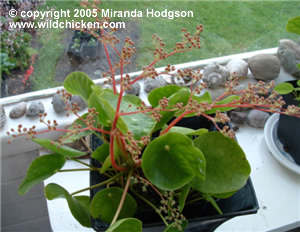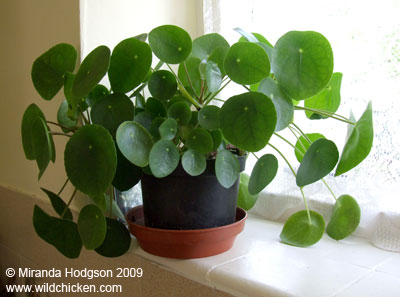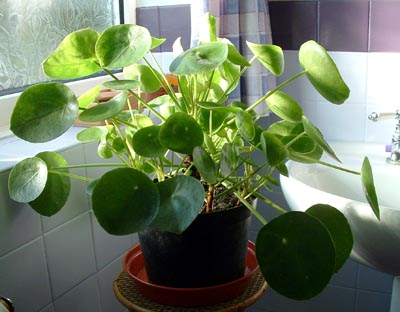


Pilea peperomioides (also called Chinese money plant and Chinese missionary plant)
Pilea
peperomioides
Native to western China. Green leaved house plant. Sprawling habit. Fairly undemanding and fast growing.
This odd-looking plant was brought to Europe from China by a Swedish missionary in, 1946. There is a very interesting article, which we have been given permission to reproduce, telling the whole story: A Chinese puzzle solved.
All year round.
Brown, cylindrical, rough, brittle, woody stems up to 30cm long.
Leathery, green, disk-shaped leaves. Young leaves glossy, dulling with age.
Petiole (leaf stalk) grows from centre of leaf disk.
Tiny white inflorescences, on pinkish stems, born in spring. Male and female flowers on same plant.
Light shade will encourage larger leaves. Leaves may scorch in bright direct sunlight.
Any fertile, moist, well drained soil.
Said to be hardy down to 0c if well drained. More likely to flower if given cool winter conditions (about 10c). Can be grown outdoors in summer. Although it grows in mountain regions in its native Yunnan, it does not survive winters outside in North Lincolnshire (I've tried it).
Trim back leggy old growth and repot in spring. Remove old leaves as necessary. Needs regular watering in warm weather. Feed regularly in growing season.
Easy to grow as long as it's kept fed and watered and is re-potted every other year or so. I was given a specimen in around 1983 and still have several offspring of the original plant.
Fairly trouble free. The only problem I've seen is a few aphids on indoor specimens, and that's been rare. If troubled by aphids during spring, summer or autumn, put the pot outside in a sheltered, shady spot and let the predator insects have them.
As the plant has so many small, upturned leaves, they can get dusty so if there is a steady rain, put the pot outside to wash it off. Don't forget to bring it back in when the sun comes out again, or the leaves will scorch and then you'll be cross.
Remove and pot up basal shoots. Stem cuttings are also possible.

Garden Plant Information list of plant care info by botanical name